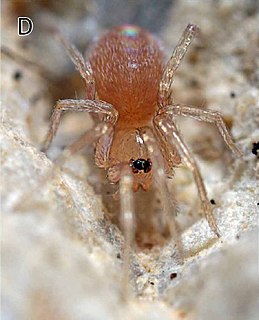
Oonopidae, also known as goblin spiders, is a family of spiders consisting of over 1,600 described species in about 113 genera worldwide, with total species diversity estimated at 2000 to 2500 species. The type genus of the family is OonopsKeyserling, 1835.

The Goliath birdeater belongs to the tarantula family Theraphosidae. Found in northern South America, it is the largest spider in the world by mass – 175 g (6.2 oz) – and body length – up to 13 cm (5.1 in) – but it is second to the giant huntsman spider by leg span. It is also called the Goliath bird-eating spider; the practice of calling theraphosids "bird-eating" derives from an early 18th-century copper engraving by Maria Sibylla Merian that shows one eating a hummingbird. Despite the spider's name, it only rarely preys on birds.

Missulena is a genus of mygalomorph spiders in the family Actinopodidae, sometimes called mouse spiders. It was first described by Charles Athanase Walckenaer in 1805. M. tussulena is found in Chile, but the rest are indigenous to Australia.

Ceratogyrus is a genus of tarantulas found in southern Africa. They are commonly called horned baboons for the foveal horn found on the peltidium in some species. They are readily distinguished from other African theraphosid genera by the combined presence of a retrolateral cheliceral scopula, composed of plumose, stridulatory setae, and the strongly procurved fovea. The fovea is typically strongly procurved and in some species surrounds a distinct protuberance. this protuberance may take the form of a simple posterior extension of the caput, a low-set plug or a prominent, discrete conical projection. All Ceratogyrus species possess a pale yellow anteriorly placed, transverse, sub-abdominal band. This feature is not distinct in other Harpatirinae except Augacephalus junodi. The absence of dense, ventral femoral fringes on the palpi and legs I and II distinguish Ceratogyrus spp. from female A. junodi.

Tarantulas comprise a group of large and often ″hairy″ spiders of the family Theraphosidae. Currently, about 1,000 species have been identified. The term tarantula is usually used to describe members of the family Theraphosidae, although many other members of the same infraorder (Mygalomorphae) are commonly referred to as "tarantulas" or "false tarantulas". Some of the more common species have become popular in the exotic pet trade. Many New World species kept as pets have urticating hairs that can cause irritation to the skin, and in extreme cases, cause damage to the eyes.
Neischnocolus is a genus of spiders in the family Theraphosidae. It was first described in 1925 by Petrunkevitch. The genus Ami was separately described in 2008, but was later discovered to be a junior synonym of Neischnocolus. Species are native to Central America and northern South America.

The Theraphosinae are a large subfamily of Mygalomorphae spiders in the family Theraphosidae found in the Neotropical realm.
Predatoroonops is a genus of goblin spiders endemic to the Brazilian Atlantic Forest. The genus is characterized by the extremely modified male chelicerae and long pairs of ventral spines. It is the first fully revised endemic Brazilian genus of spiders, uncovered in 2012 after two and a half years of research at São Paulo's Instituto Butantan.
Mascaraneus is a monotypic genus of African tarantulas containing the single species, Mascaraneus remotus. It was first described by R. C. Gallon in 2005, and is endemic to Mauritius.
Envia is a spider genus in the family Microstigmatidae, found only in Brazil.
Bumba is a genus of tarantula native to the Americas. It is an uncommon genus, comprising only four known species, including one named after John Lennon. Like most related species in the subfamily Theraphosinae, they may flick urticating hairs in response to threats.
Bumba lennoni is a species of tarantula found in 2015 in Caxiuanã National Forest. It is about one inch long, small for a tarantula but is closely related to the largest spider in the world.
Bistriopelma is a genus of spider, being a theraphosine theraphosid (tarantula). It has two species as of February 2016, both of which are found in Peru.
Tmesiphantes mutquina is a species of theraphosid spider, in the subfamily Theraphosinae. It is native to Argentina.

Kankuamo marquezi is the only species within the monotypic spider genus Kankuamo, in the family Theraphosidae. It is found in the Sierra Nevada de Santa Marta, Colombia. This spider has urticating hairs, the first to be classified as type VII. These sword-shaped, bristly hairs are used as a defense mechanism by stinging or stabbing. Most other species of tarantulas attack by throwing their hairs from a distance. Kankuamo hairs cover the entire body and have penetrating tips which will embed themselves into the skin or mucous membranes and cause severe irritation. Humans often experience mild to severe skin irritation or rashes.
Augacephalus is a genus of harpacterine theraphosid spiders. It has three species, all of which are found in Africa.

Megaphobema is a genus of tarantulas that was first described by Reginald Innes Pocock in 1901. They look similar to members of Pamphobeteus except for its legs; the third and fourth pairs of legs are much larger and stronger than the first two pairs.
Magnacarina is a genus of spiders in the family Theraphosidae. It was first described in 2016 by Mendoza, Locht, Kaderka, Medina & Pérez-Miles. As of 2017, it contains 4 species.







